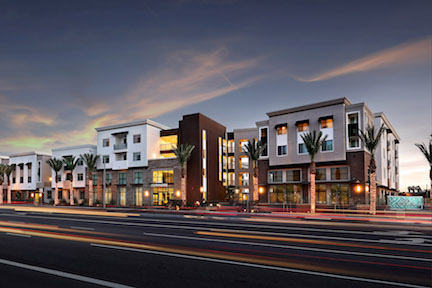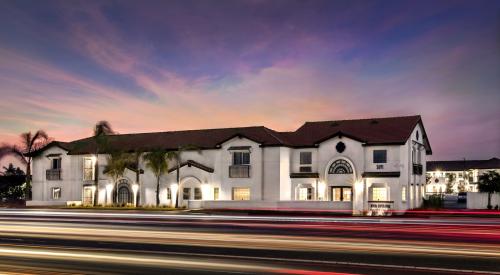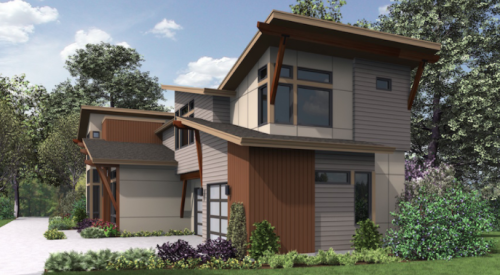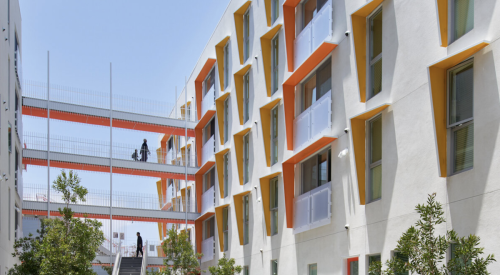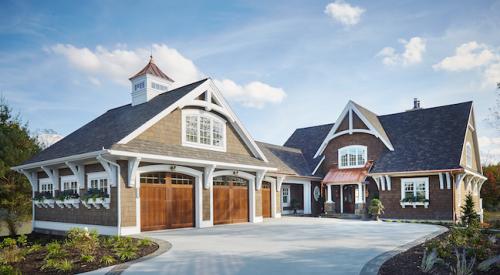As the dearth of affordable market-rate housing grabs headlines, nonprofit and for-profit developers are focusing on making affordable housing the best it can be. They’re reclaiming and transforming underutilized sites for new housing that connects residents to the surrounding community, welcomes visitors, and also improves the neighborhood. Diverse populations, including seniors, homeless veterans, and families, are served by these projects.
Rather than isolate low-income renters in high-rise buildings, new affordable-housing projects offer numerous ways for them to stay connected, such as dog runs, community gardens, computer rooms, and barbecue areas. Projects don’t scream “affordable.” Instead, they blend into their surroundings and invite pedestrians to sip coffee in the courtyard or shop at one of the ground-level retail shops.
“The goal is to build new housing that will enhance property values,” says Jim Schmid, CEO of Chelsea Investment Corp., a developer in Carlsbad, Calif., that focuses on affordable housing.
Affordable-housing developers, and their partners, know projects are most successful when they meet these parameters:
• Designed to look like market-rate housing and respectful of neighborhood architecture.
• Built with energy efficiency and sustainability in mind.
• Include recreation and common areas for socializing.
• Engage the surrounding community with new retail businesses and public gathering spaces.
The Fight for Financing
The biggest hurdle is money. “If the sites aren’t in a well-funded county, it’s hard to assemble enough resources to construct attractive projects,” says developer Victor Rodriguez, president at A.M. Rodriguez Associates, in Pittsburgh.
The federal Low-Income Housing Tax Credit (LIHTC) is still a viable funding source, but how the Republican party’s proposed tax reform plan will affect the LIHTC is anybody’s guess. Developers are tapping other sources such as conventional loans from private lenders and subsidies from city, county, and state agencies. “You need more and more non-tax-credit subsidies to get the deal done,” says Chelsea Investment’s Schmid.
Several encouraging bills have been introduced in the California state legislature, including SB-2, the Building Homes and Jobs Act, which would create a permanent funding source for affordable housing through a new real-estate fee, and SB-3, the Veterans and Affordable Housing Bond Act of 2018, which will put a $4 billion bond on the ballot in November 2018.
It’s easier to fund smaller projects, Schmid says; tax credits are more likely to be awarded to a 50-unit development than an 80-unit project. Notes Vicky Ramirez, senior project manager for Jamboree Housing, a nonprofit developer based in Irvine, Calif., “Project efficiencies and financial viability are generally maximized with a 50-to-80-unit development.”
It’s typical for affordable-housing projects to be developed as joint ventures. Various entities involved may include government agencies, private lenders, builders, architects, and property managers. Naturally, everything depends on the willingness of the partners to collaborate and compromise.

El Monte Veterans Village is a three-story building designed in a style evocative of National Park lodges. The project offers 42 studio apartments exclusively for homeless veterans. Mercy Housing California is the developer, with design by TCA Architects. Photo: Courtesy TCA Architects
Refuge for Homeless Veterans
The city of El Monte, Calif., east of Los Angeles, makes it a priority to care for its large veterans population. A shining new example is El Monte Veterans Village, a permanent supportive housing community exclusively for homeless veterans.
Built on an underutilized parcel adjacent to an industrial area and across the street from a single-family neighborhood, El Monte Veterans Village is close to public transit and the local Veterans of Foreign Wars post. There are 42 studio apartments in a three-story building whose style evokes National Park lodges—or, as architect Eric Olsen says, a Craftsman style that the city found appealing. “We made sure the building conveyed the idea of home on a larger scale,” says Olsen, of TCA Architects, in Los Angeles, “rather than emphasizing the individuality of the units.” The building wraps around a central courtyard with a built-in barbecue and a large stone fireplace. “It focuses circulation on outdoor space where the vets can hang out,” he says.

A courtyard with a fireplace and barbecue grill, located off the community room, is a welcoming place for residents to relax and socialize. Photo: Courtesy TCA Architects
Mercy Housing – California developed the project in partnership with the city and an on-site provider, New Directions for Veterans, that will oversee supportive services such as case management, health and wellness programs, benefits claims assistance, and substance-abuse recovery support. “We wanted something that didn’t look like an institution and had features that would help veterans assimilate back into the community,” says Erika Villablanca, Associate Director–Real Estate Development at Mercy Housing, in Los Angeles.

Setbacks at the fourth floor of the eight-story senior building at Soundview decrease the imposition of the massing and help maintain views from existing public housing on the site. Sunshades on the south and west façades mitigate solar gain and decrease air conditioning use. Photo: Seong Kwon Photography
A Boost for the Bronx
On the site of two former parking lots in the south Bronx, Soundview Family and Soundview Senior Housing add 206 housing units for low-income families and seniors. The project is a joint venture of CPC Resources, The Lemle & Wolff Cos., and L+M Development Partners, all based in New York.

Soundview residents have direct access from ground-floor lounge spaces to the shared, landscaped open space between the two buildings. Photo: Seong Kwon Photography
The apartments are adjacent to Soundview Park, one of the largest parks in the Bronx. The site was an irregular, narrow parcel with frontage on a cul-de-sac that had been mapped but not built. By finishing construction of the street, developers brightened a dark and unsafe area, says Christine Hunter, principal of Magnusson Architecture and Planning, in New York.
To relate to the adjacent New York City Housing Authority high-rises, says Hunter, the eight-story seniors’ building is set back from the street and the nearby NYCHA buildings, while the three-story family buildings complement older three-story neighborhood homes. The landscaped outdoor space, which includes a number of mature trees, is accessible to all residents. “Soundview is a considerate, efficient, and beautiful example of affordable housing added to an existing public-housing campus,” says Elizabeth Propp, senior VP at CPC Resources.

The apartments at ONE Homestead are built over ground-floor retail that will help spur commercial activity in the neighborhood, says developer Victor Rodriguez. Photo: Denmarsh Photography
First New Apartments in 40 years
Homestead, Pa., 6 miles southeast of downtown Pittsburgh, was in dire need of quality rental housing, says local developer Victor Rodriguez. Once a thriving steel town, Homestead had seen no new apartment construction in more than 40 years. Rodriguez decided an injection of new residential construction was needed to change perceptions about the town.
The property assembled for One Homestead is spread out over six buildings and five parcels. There are 51 units: a combination of apartments, townhomes, flats, and lofts ranging from 747 to 1,761 square feet. One building is a renovated post office with three loft units for low-income households and a community room with a kitchenette, TV, and computers.

One of the six buildings at ONE Homestead is an old post office that was converted into three loft units for low-income families. The developer was a.m. Rodriguez Associates, with design by Paul Rodriguez. Photo: Denmarsh Photography
One Homestead was financed through a combination of the LIHTC, Keystone Community funds from the Pennsylvania Housing Finance Agency, funds from Allegheny County’s Department of Economic Development and the Pennsylvania Redevelopment Capital Assistance Program, and loans from The Bank of New York Mellon and the Steel Valley Enterprise Zone.
Victor’s architect brother, Paul, used materials evocative of surrounding buildings in his design. “The [architecture] reflects some of the prominent elements of the Mary Magdalene Church, a beautiful old structure on Amity Street,” Victor says. “The brick pseudo-buttresses of the church were picked up in the vertical brick details of the townhomes adjacent to it.”
Affordable For Working Families
Clark Commons provides affordable workforce housing for families earning between 30 and 60 percent of the area median income. The project is part of a market-rate master planned community in Buena Park, Calif., and the result of a public-private partnership between Jamboree Housing and Irvine, Calif.-based City Ventures. The partners purchased the 10-acre site from the city of Buena Park, which in turn provided a land-loan note to Jamboree as well as gap funding. Tax-credit equity from the sale of LIHTCs and a conventional mortgage from Bank of America were also part of the package.

Clark Commons, an affordable apartment community for families in Buena Park, Calif., was designed as a podium building with surface parking, a tot lot, and a barbecue area on the ground floor. "The massing is on a human scale, with penetrations that give it a friendly face," says architect Mike Boyd of Danielian Associates, Irvine, Calif. Photo: For Jamboree by JuanTallo.com
“Similar to the rest of the state, the need for a mix of housing for Buena Park residents has been the most pressing issue,” says Jamboree’s Ramirez. “Jamboree and its partners are committed to working together for the long term to ensure that [Clark Commons] will remain well-maintained and affordable, thus providing well-designed, quality housing in a jobs-rich location near local schools.”
On the former site of an old city public-works yard and an underutilized commercial strip center, the developers created 70 apartments and a two-story community facility with a conference room, computer lab, and space for educational classes, as well as a kitchen, fitness room, centralized laundry room, and secured overnight bike storage. Outdoor amenities include a tot lot, barbecue areas, and seating areas.

Clark Commons has been well received, says Jamboree Housing's Vicky Ramirez, due to the developer's strong partnership with local community groups who use the community facility to provide programs such as job-skills training and after-school tutoring. Shown here is the computer lab/homework room. Photo: For Jamboree Housing by JuanTallo.com
“Residents have access to a ½-acre park located next to our property,” Ramirez says. “[Clark Commons] is also located in close proximity to public transportation, an elementary school, and shopping, and one of the residential buildings has a ground-floor restaurant and coffee shop.”
The design of the building is contemporary and was developed in close collaboration with the city of Buena Park to ensure compatibility with the surrounding neighborhood. “The architecture is eclectic,” Ramirez says. “There are [even] some 1950s ranches.” Adds architect Mike Boyd of Danielian Associates, in Irvine, Calif., “We wanted to do something that would not only blend with the commercial street, but also be a bridge to the architecture that was happening in the master plan.”
Landscaping: An Essential Component
In affordable housing, where the goal is to make the outdoor spaces as attractive as possible on a tight budget, landscaping can make a world of difference.
“As land becomes less available and more costly, and units get smaller, there is a greater demand for open space,” says Rob Pressman of TGP Landscape Architecture, in Burbank, Calif., “so we need to maximize it as much as possible.”
Amenities in affordable-housing developments are more upscale and include barbecue/dining areas, tot lots, dog parks, bike racks, and fire pits or fireplaces. “To add visual interest in high-traffic areas, we use concrete pavers, brick, and tile,” Pressman says. TGP specifies plant materials for those areas that are substantial in size to act as a visual buffer and to give the space softer edges.
Landscaping adds appeal to affordable projects. To stay on budget, TGP Landscape Architecture used off-the-shelf fiberglass planters on the roof deck at Downey View, in Downey, Calif. The developer is National Community Renaissance, with design by Togawa Smith Martin. Photo: Ryan Beck Photography
Landscaping is just as important to resident safety as outdoor lighting and locks, says Vicky Ramirez of Jamboree Housing, in Irvine, Calif. “[Choosing the right] landscaping [and maintaining it properly] are key to minimizing fire threat and creating open spaces that are free of overgrown areas that obstruct vision and allow trespassers a place to hide,” she says.
